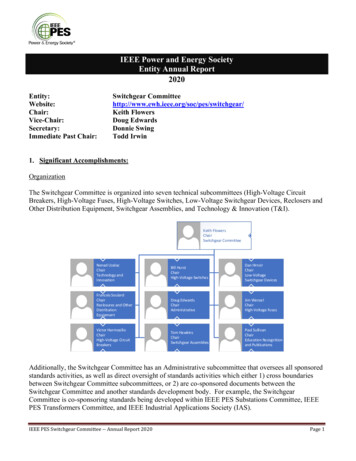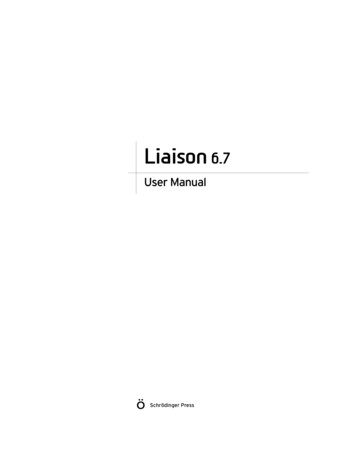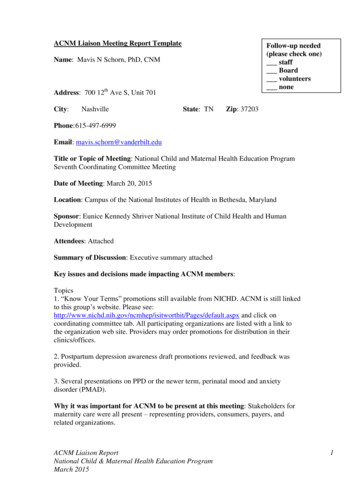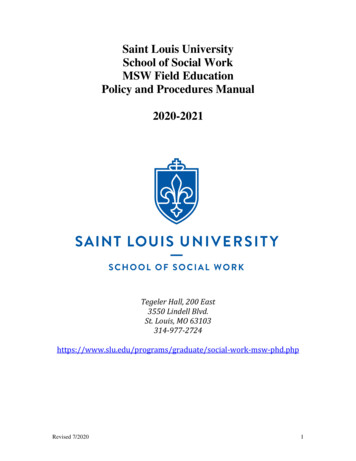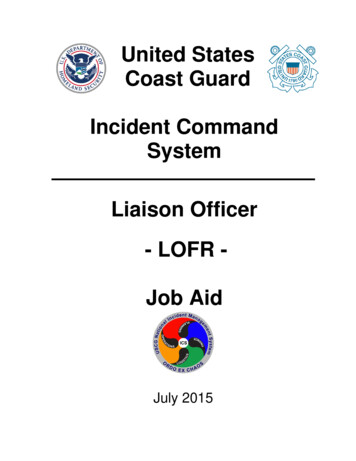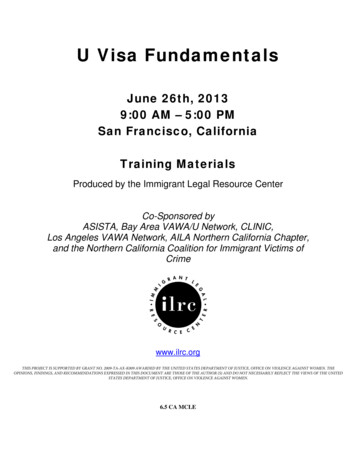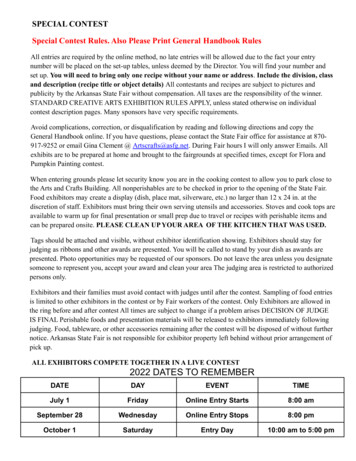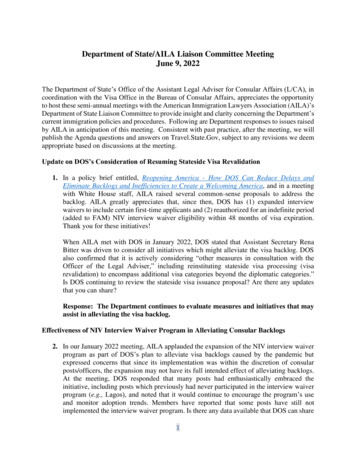
Transcription
Department of State/AILA Liaison Committee MeetingJune 9, 2022The Department of State’s Office of the Assistant Legal Adviser for Consular Affairs (L/CA), incoordination with the Visa Office in the Bureau of Consular Affairs, appreciates the opportunityto host these semi-annual meetings with the American Immigration Lawyers Association (AILA)’sDepartment of State Liaison Committee to provide insight and clarity concerning the Department’scurrent immigration policies and procedures. Following are Department responses to issues raisedby AILA in anticipation of this meeting. Consistent with past practice, after the meeting, we willpublish the Agenda questions and answers on Travel.State.Gov, subject to any revisions we deemappropriate based on discussions at the meeting.Update on DOS’s Consideration of Resuming Stateside Visa Revalidation1. In a policy brief entitled, Reopening America - How DOS Can Reduce Delays andEliminate Backlogs and Inefficiencies to Create a Welcoming America, and in a meetingwith White House staff, AILA raised several common-sense proposals to address thebacklog. AILA greatly appreciates that, since then, DOS has (1) expanded interviewwaivers to include certain first-time applicants and (2) reauthorized for an indefinite period(added to FAM) NIV interview waiver eligibility within 48 months of visa expiration.Thank you for these initiatives!When AILA met with DOS in January 2022, DOS stated that Assistant Secretary RenaBitter was driven to consider all initiatives which might alleviate the visa backlog. DOSalso confirmed that it is actively considering “other measures in consultation with theOfficer of the Legal Adviser,” including reinstituting stateside visa processing (visarevalidation) to encompass additional visa categories beyond the diplomatic categories.”Is DOS continuing to review the stateside visa issuance proposal? Are there any updatesthat you can share?Response: The Department continues to evaluate measures and initiatives that mayassist in alleviating the visa backlog.Effectiveness of NIV Interview Waiver Program in Alleviating Consular Backlogs2. In our January 2022 meeting, AILA applauded the expansion of the NIV interview waiverprogram as part of DOS’s plan to alleviate visa backlogs caused by the pandemic butexpressed concerns that since its implementation was within the discretion of consularposts/officers, the expansion may not have its full intended effect of alleviating backlogs.At the meeting, DOS responded that many posts had enthusiastically embraced theinitiative, including posts which previously had never participated in the interview waiverprogram (e.g., Lagos), and noted that it would continue to encourage the program’s useand monitor adoption trends. Members have reported that some posts have still notimplemented the interview waiver program. Is there any data available that DOS can share1
about the adoption rate by posts of the NIV interview waiver initiatives and/or its impacton visa backlogs?Response: The vast majority of posts worldwide use at least one interview waiverauthority to process cases without an interview. We estimate 30 percent of allnonimmigrant visa applicants could benefit from interview waiver and not need tovisit our waiting rooms.Numerical Controls Division3. Following Charlie Oppenheim’s retirement late last year, AILA understands that an ActingDirector is leading the Numerical Controls Division. Has DOS posted the position yet? Ifso, has someone been selected to replace Charlie in this role?Response: The Visa Office does not comment on HR processes.4. Given that consular posts are opening up and issuing IVs again, it seems likely that therewill be significantly fewer unused family-based preference numbers added to FY 2023’semployment-based visa number allocation than in the past two years. Based upon currentdata and processing trends, can the Numerical Controls Division please comment on howmany family-based immigrant visa numbers it anticipates may go unused? What steps isDOS taking to ensure that immigrant visa numbers are fully utilized?Response: The Visa Office cannot offer a reliable estimate at this time, as postscontinually adjust their processing capacity per the established COVID protocols intheir respective host countries; however, the Department has issued more familybased preference visas in the first half of FY 2022 than it did in all FY 2021.5. AILA appreciates that DOS publishes monthly IV and NIV visa issuance statistics. IVstatistics are currently published in a manner that requires significant manual calculationto determine the number of visas used each month in the various immediate relative andpreference categories. Would DOS consider publishing aggregated data to enable thepublic to more easily see the number of immediate relative and preference number usageeach month? Would DOS consider publishing data in a dashboard format that would allowthe data to be presented in multiple formats?Response: The Visa Office continually evaluates the best way to provide publiclyavailable statistics and appreciates your suggestions.6. AILA members’ clients (especially EB-2 and EB-3 Indian and Chinese-born clients) areworried that the Final Action Dates may retrogress in October 2022. AILA and the publicno longer receive information through the Chats with Charlie YouTube event. It is nowmore important than ever to open up avenues of communication with the public about whatmovements Numerical Controls is predicting in the final action dates and dates for filing.Is DOS’s Public Outreach group considering any public engagement over the comingmonths to address this desire for information? Can Numerical Controls consider including2
predictions more frequently in the Visa Bulletin as we approach the end of FY22?Response: The Bureau of Consular Affairs will continue to engage with the publicthrough its Travel.Gov social media platforms and is constantly evaluating the mosteffective ways to communicate with the public.7. Has DOS issued guidance to posts on the reauthorization of EB-4 Certain ReligiousWorkers and EB-5 Regional Centers, and have posts resumed scheduling IV interviews forthese categories?Response: Yes, posts have been advised that both programs are authorized andexisting applicants may be processed.E Visa Questions8. In January 2022, AILA expressed concerns that some posts have stopped processing Evisas, including Ankara, Bogota, and Bridgetown. DOS indicated that E visa processingwas likely to improve through a combination of resumption of pre-COVID-19 processingand knowledge-sharing, which would allow personnel at other posts or in the United Statesto process E visa cases remotely. However, severe delays continue to be a problem. Forexample, the Embassy in Santiago, Chile posted that it is suspending E-1 and E-2processing; Dublin, Ireland is posting backlogs of 8 months for E-2 applications forpreviously registered companies and 12 months for new registrations; and E-1 and E-2applications in Toronto, Canada are delayed over 300 days. Also, Amman, Jordan informedan AILA member that it was not accepting new E visa applications, only renewals. As Evisa processing remains extremely delayed and, in some cases, has stopped--at greatexpense to companies and individuals seeking to contribute to the U.S. economy--pleaseconfirm the following:a. What steps has DOS taken to creatively utilize its resources to address the situation?Response: Exercising authority under INA section 222(h)(1)(C)(i), theSecretary determined that interview waiver for certain NIV applicantsrenewing in the same classification within 48 months of the prior visa’sexpiration is in national interest. This authority potentially is available for Evisa renewals; however, while the Department encourages overseas posts touse this authority where appropriate, posts are primarily responsible forimplementing that authority and we do not have information on the extent towhich it has been exercised in this context. The Kentucky Consular Centeralso remains able to assist post with prescreening for cases, if domesticverification is needed to assist with adjudication.b. Are consulates sufficiently staffed to adjudicate E visa cases at pre-pandemiclevels? Many of the embassies and consulates that historically adjudicate thegreatest volume of E visa cases have resumed with processing.3
Response: More generally, the Bureau of Consular Affairs continues to workwith the rest of the Department to rebuild lost capacity and to fill positions leftvacant during the pandemic. Despite the easing of the funding challenge, theprocesses for hiring, security clearances, training, and deployment for anoverseas consular officer to arrive at an assignment takes over a year. Staffingresources are directed to posts with the most urgent needs, such as thoseprocessing Afghan Special Immigrant Visas, supporting Ukraine efforts, andhigh-volume immigrant visa posts.9. Recently updated 9 FAM 402.9-10 serves as a centralized source and has an extensive listof the treaties and laws containing trader and investor provisions in effect between the U.S.and other countries (CT:VISA-1297: 06-04-2021) with footnotes on peculiarities in eachtreaty. Section 402.9-10 is followed by specific instructions on the required forms, and asuggested checklist of documents with tabs is provided. The FAM also refers officers tothe E Visa Portal on CAWeb for training. Most recently, the FAM was updated to includea provision at 9 FAM 402.9-7 (D) on the E-Visa Company RegistrationPrograms/Databases, specifically discussing the “utility and efficiency” of this program byconsular posts that implement this program. In its totality, these combined resources are acomprehensive center of information for all foreign service officers regardless of theiroverseas post assignments. Moreover, DOS regulations at 22 CFR 41.101 (1)(ii) permit aconsular officer to take jurisdiction over a foreign national’s nonimmigrant visa (NIV)application based on physical presence or as directed by DOS through the Deputy AssistantSecretary of State for Visa Services. Given the centralized nature of the resources andauthorization to adjudicate cases in other countries, has DOS taken steps to train officersin multiple locations and jurisdictions to handle E visa applications from jurisdictions inwhich consular posts have been incapable of setting E visa appointments? If steps are beingtaken, please provide the specifics.Response: Individual applicants, of course, can apply at any consular section at whichthere is appointment availability and in a country in which they are present. We alsonote that Transplanting an entire operation to another locale, is not always the mostefficient way to process visas or reduce backlogs. As posts work through their twoyear backlogs and the pandemic recedes, we are hopeful posts will return to normaloperations and provide the full range of services that were provided prior to theCOVID-19 pandemic.EB-5 RIA Implementation10. Has DOS liaised with USCIS regarding the visa set-asides for rural, high unemployment,and infrastructure projects established by the EB-5 Reform and Integrity Act of 2022(RIA)? If so, how will these visas be allocated?Response: DOS continues to liaise with USCIS on the implementation of the EB-5Reform and Integrity Act of 2022 (RIA). The set-aside categories will be allocatedvisas as outlined by the RIA.4
a. When will DOS and USCIS publish joint guidelines on the visa set-asides createdby the RIA? Will DOS add notes to the Visa Bulletin to provide guidance on thenew set-asides?Response: As noted above, DOS continues to liaise with USCIS onimplementation of the RIA. The Visa Bulletin describes the new set-asides.11. What process will DOS and USCIS adopt moving forward on newly filed cases to clearlydesignate I-526 petitions that fall into set-aside categories so that DOS can clearlydistinguish which petitions receive the set-asides?Response: New EB-5 visa categories were established to distinguish between thevarious set-aside categories as well as whether the I-526 petition is for a regionalcenter project or a non-regional center project.What process will DOS/NVC and USCIS adopt moving forward on approved I-526petitions to clearly designate I-526 petitions that fall into one of the set-aside categories sothat DOS can process them in accordance with the reserved visa set-asides for rural, highunemployment, and infrastructure categories?Response: DOS cannot speak to the petition approval process and designation byUSCIS, but DOS will process the application per the approved EB-5 visa category.12. Have USCIS and DOS worked out a process to identify pending or approved petitions thatmay qualify for reclassification (or petition portability) under the RIA’s new reserved visaset-aside rules? For example, if there is a Chinese national with a pending or approved I526 petition filed under the 5th preference Unreserved (I5 and R5) category with abacklogged January 2017 filing date now seeking reclassification under the identical EB5 Preference Set Aside: (Rural – 20%) category do DOS and USCIS plan to allow upgradesor reclassification of a prior rural-based unreserved regional center case to a rural-basedreserved set-aside? This needs to be done in accord with DOS’ general policy to givepriority to those petitions that have already been filed, particularly when the definition ofrural under the prior statute is identical to that under the RIA.Response: Pending petitions filed prior to the enactment of the EB-5 RIA will beadjudicated under the law in effect at the time of filing. Petitions approved prior tothe enactment of the EB-5 RIA will retain the classification set by USCIS at the timeof approval.13. Before the recent Congressional reauthorization of the EB-5 regional center program,AILA members reported being told that the NVC had no way of distinguishing betweenEB-5 regional center and non-regional center cases and, as a result, was not sending anyEB-5 cases to post for adjudication.a. What efforts is DOS taking to ensure that these categories are separately reportablein its systems?5
Response: NVC is able to distinguish between regional center and nonregional center applications and continued to process non-regional centerapplications during the lapse in the former regional center program. Since thepassage of the RIA, new EB-5 visa categories were established in order to cycle.b. Are there plans to classify EB-5 cases that were already approved and are pendingat the NVC and consular posts?Response: As stated above, petitions approved prior to the enactment of theEB-5 RIA will retain the classification set by USCIS at the time of approval.c. Can DOS confirm whether NVC is sending both types of EB-5 cases (regionalcenter and non-regional center) to post for adjudication and interview?Response: Yes, NVC is processing all EB-5 cases that were grandfathered-inby the EB-5 Reform and Integrity Act.NVC Issues14. NVC recently started requiring applicants to submit documents that are not required underthe FAM or are inappropriate for that individual’s particular circumstances. For example,contrary to 9 FAM 504.4-4(B), many IV applicants without a criminal record are receivingrequests for police certificates for countries in which the individual previously resided forless than a year. Similarly, many IR/CR-1 applicants whose U.S. spouse has been regularlyresident outside the U.S. and who, per 9 FAM 601.14-6 d, may be relying on assets toestablish I-864 Affidavit of Support eligibility, are being told they must provide W-2s forperiods of employment abroad and a joint sponsor. Can VO/LA please confirm whetherthere have been any changes to its policy regarding these requirements, and if not, couldNVC please examine its processes and train its officers on these issues?Response: NVC follows the guidance in 9 FAM 504.4-4(B) for collecting policecertificates for countries in which individuals previously resided for a year. However,there is a known issue with CEAC requesting police certificates for some applicantswho lived in a country for less than one year. Case parties should reviewhttps://nvc.state.gov/document for police certificate requirements. If you are notrequired to submit a police certificate that CEAC is asking for, instead submit athttps://nvc.state.gov/troubleshooting for known issues and statuses.NVC’s processes for Affidavit of Support eligibility remain the same per 9 FAM601.14-6 d. NVC will request W-2s for periods of employment if a sponsor submitteda copy of a tax return (1040) regardless of the filing status or if the sponsor submittedan original tax transcript and is using only his/her income to meet the povertyguidelines. Please provide NVC additional detail for any case where this procedure6
has not been followed to enable supervisory review and additional training ifnecessary.15. NVC recently declined to accept G-28s for U.S. barred attorneys where bar admission intoa U.S. state was listed. The NVC states that they cannot accept the G-28 for someone who“.is practicing law outside the U.S. or U.S. territory.” NVC quotes 8 CFR1.1(f) and statesthat NVC “can only add attorneys who are admitted to practice in the U.S.” Can NVCplease advise the contractors from LDRM that a U.S.-qualified/U.S.-barred attorney whohappens to work outside of the U.S. are eligible to be designated as the attorney of recordfor an applicant?Response: As part of its standard process, NVC follows the procedure in 9 FAM603.2-9 for adding U.S. barred attorneys to cases. Please provide NVC any additionalinformation you may have about the petitions with declined G-28s to enablesupervisory review and additional training if necessary.16. AILA members have seen multiple examples where USCIS approved a petition and thepriority date is current, but no NVC case number has been issued, preventing the case frommoving forward as no fee can be paid, no DS-260 can be prepared, and no documentationcan be submitted to the NVC. Attorneys have followed up multiple times through theappropriate attorney form online, requesting the case number to be issued, and sent emailsto the NVC research box. Unfortunately, responses from the NVC continue to state that“(I)t can take up to six weeks for an approved petition from USCIS to arrive at the NVC.”How can AILA members obtain a case number for cases where it has been more than sixweeks or longer since the petition approval and efforts following the previously advisedprotocols have not seemed to resolve the issue?Response: NVC is unable to create a case or issue a case number until it receives anapproved petition from USCIS. There is a known issue with some approved petitionstransferring from USCIS to NVC. USCIS has made changes to their system and isworking with DOS to fix the remaining petitions. If it has been more than sixty (60)days after receiving an I-797 Approval Notice from USCIS, and NVC did not receiveyour client’s approved petition, we recommend emailing NVCResearch@state.govfor assistance. Please provide a copy of your client’s I-797 Approval Notice and anyadditional information you may have about the petition. NVC will work with USCISon your client’s behalf to locate the petition and have it transferred to NVC.17. 9 FAM 504.4-4(B) includes an exception to the general rule that police certificates arerequired from any country of prior residence in which an IV applicant has lived for oneyear or more since attaining the age of 16. The exception reads: “If an applicant haspresented a comprehensive police certificate fully meeting the requirements of 22 CFR42.65(c) from the applicant’s country of principal residence, you need not require a policecertificate from other places of former residence, provided the applicant presents othersatisfactory evidence of good conduct.” What does the term “comprehensive policecertificate” mean?7
Response: Documents that meet the requirements of 22 CFR 42.65(c) are considered“comprehensive police certificates,” if issued by the police or other appropriateauthorities and include all reporting information entered in their records relating tothe alien.CEAC IssuesUpdating Form DS-26018. Once Form DS-260 is submitted, it cannot be changed. Applicants submit DS-260s at theNVC stage for the case to become documentarily qualified and then wait for one to twoyears for an interview. In some cases, the information on the form becomes outdated duringthis time. However, given that the document is locked and there is no option to submit anew DS-260, please confirm how DOS prefers applicants update the information includedto reflect updates from after submission but before the IV appointment?Response: Our systems are not designed to allow a DS-260 to be reopened after it hasbeen received and reviewed by NVC. Reopening would take the case out of theintended processing path and further, if NVC were to re-open a DS-260 after a casewas documentarily complete, the case would lose its ‘spot in line’ for scheduling, as anew documentarily complete date would be applied to the case. Instead, once the casehas been scheduled the post can be informed that there are changes that need to bemade to the DS-260, and post can reopen the document to allow updates to be madethrough the CEAC portal. Likewise, the visa applicant can and should inform theofficer at the interview of any information on the form that has become outdated sothat the form can be annotated or reopened to be amended by the applicant, asappropriate (see 9 FAM 504.5-3(A) for more information).Nomenclature Protocols for Uploading Documents to CEAC19. It is in AILA’s, NVC’s, and the Consulates’ best interest to locate documents quickly andefficiently, and we would welcome tips on how to make this easier and more efficient forDOS. AILA recognizes that only a few characters of the uploaded file names are visible.When uploading documents to CEAC where there is a specific CEAC classification, doesDOS have a preferred naming convention to facilitate recognition of the documents?Similarly, does DOS have a preferred naming convention for documents uploaded into the“other” category?Response: The filenames that the case parties enter are not displayed in our systems- only the document type is displayed. What is most important is that the case parties: Upload multipage documents as one file.Upload documents ‘right-side’ up. See nvc.state.gov/scan for best way to scandocuments to help NVC review efficiently.Select the appropriate document type label in CEAC.8
Upload only documents that are required for the case (i.e. no pictures orsuperfluous documents). See nvc.state.gov/fin and nvc.state.gov/document fordocument requirements.Ensure documents are uploaded under the right sponsor or applicant name.Immigrant Visa Appointments20. In January 2022, DOS noted that “(p)rocessing of immediate relative and K visaapplications, and family preference cases consistent with Congressional direction remainsa priority.” Have there been any changes to these priorities since January?Response: Since the tiered prioritization for immigrant visa processing was rescindedin November 2021, the Department does not dictate any prioritization; however, postsare encouraged to strive to process immediate relative and K visa applications, andfamily preference cases, consistent with Congressional direction. NVC continues toschedule documentarily complete IV cases, working with posts to adjust for interviewcapacity.21. The process of scheduling IV applications for interviews seems to be moving forward veryslowly, especially for family-based applicants from the Middle East and North Africa whowere affected by the travel restrictions for Muslim/African countries. DOS website postsmonthly updates regarding how many applications are interviewed each month.a. Can data be provided regarding how many applications are waiting to beinterviewed at each post?Response: The Visa Office is not able to provide a post-by-post breakdown nformationresources/visas-backlog.html, which will be updated with current numbers everymonth.b. Is prior guidance related to prioritizing the processing of applications negativelyaffected by the EOs still in effect?Response: Yes, posts that have a significant number of applications previouslyrefused under Proclamations (P.P.) 9645 and 9983 have been reminded as recentlyas April 2022 to continue prioritizing these applications. IV applicants previouslyrefused under P.P. 9645 or 9983 who want to reopen their application shouldcontact the embassy or consulate where their application was refused to determinenext steps for moving their case forward.Administrative Processing9
22. Members are reporting an uptick in administrative processing. AILA realizes that nationalsecurity concerns may drive Security Advisory Opinions (SAOs) and that DOS is not atliberty to discuss SAOs or even indicate what triggered the SAO. Based on AILA’sobservations, much of the “administrative processing” may not be SAOs, butadministrative delays in issuing the visas. Can DOS please comment on whether posts areexperiencing delays in administratively issuing visas (not SAO-related) due to dualworkstreams of visa interviews and nonimmigrant visa interview waiver cases? Being ableto distinguish between “administrative processing” that is an SAO and a delay in printingthe visa would be very helpful in terms of setting expectations. Would it be possible forposts to make this distinction and indicate that they are “X” weeks behind in printing thevisa?Response: Unfortunately, the Department is not always able to specify the cause fordelays, nor can we typically specify the amount of time a case will take to resolve,whether for security advisory opinions or for operational issues like delays inprinting. Typically, however, visas are printed within several days after a consularofficer makes the issuance decision.23. AILA members report some extremely delayed SAOs, dating back to before the COVID19 global pandemic. It is disconcerting to AILA members and their clients when processingtimes are so open-ended that it appears a final decision may never be reached. Pleaseaddress the following questions:a. While we realize that SAOs have different triggers and may involve multiplegovernment agencies, making it difficult to provide an average timeline forresolution, can you please comment as to whether these cases are generallyprocessed on a first-in, first-out (FIFO) basis or a last-in, last-out (LIFO) basis?Response: The Department processes cases when all necessary interagencyresponses have been received. Whenever possible, the oldest cases areprocessed first, but that is not always possible.b. Does DOS (and/or other involved agencies) have a plan for resolving these mattersand/or a goal to clear these long-pending matters by a particular date?Response: The Department remains committed to resolving cases andcontinually seeks to improve efficiency while maintaining high standards.This summer we will implement new workflow processes for some cases thatwe anticipate will reduce the administrative processing volume, although weare unable to provide a more precise timeline for resolving long-pending cases.Applicants are advised to direct status-related questions to the post with whichthe case is pending.c. What is the best way that an attorney can confirm that an application is being actedupon and has not slipped through the cracks when an SAO has been pending sincebefore the pandemic?10
Response: Applicants are advised to direct status-related questions to the postwith which the case is pending.d. What is the best way an attorney can request final action on a case that has beenpending for this excessive amount of time?Response: Please see our response to the preceding question.24. Administrative processing delays continue to grow for clients from the Middle East andAfrica. Former Deputy Assistant Secretary, Ed Ramotowski, testified before Congressabout new automated processes for background clearances in relation to concerns aboutMuslim Travel Ban EO 9645. AILA is interested in understanding the current status ofthese cases. Please confirm the following:a. Have the automated processes improved the clearance process?Response: Yes.b. How many of these cases remain in administrative processing?Response: There are no cases pending administrative processing due toconcerns associated with P.P. 9645, but some cases may be pendingadministrative processing for other reasons.c. What is the average time to resolve these cases?Response: Applicants’ circumstances are unique and there may be severalfactors hindering the application from being processed to completion,including additional administrative processing, difficulty updating themedical examination due to travel restrictions in country, unresponsiveapplicants, etc. We do not have statistics on the average time to resolve thesecases, but some applicants were issued visas within days of P.P. 9645 and 9983being revoked, whereas other applicants have never reached out to theembassy or consulate where their application resides to continue processingtheir case.d. Can you please provide statistics as to how many have been favorably resolved?Response: These statistics are not available.Transmission of I-612/I-613 Requests for Recommendation from USCIS to WRD25. AILA members are experiencing a persistent problem with USCIS not transmitting FormsI-612/I-613s in hardship and persecution waiver applications from USCIS CSC to DOS11
Waiver Review Division (WRD). In numerous instances, many months elapse betweenwhen USCIS indicates it has sought the recommendation from DOS WRD and theassociation of the I-612/I-613 with the waiver ap
Jun 9, 2022
